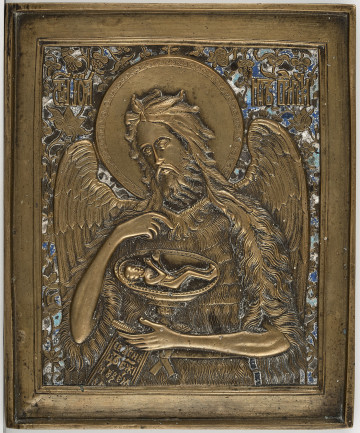
St. John the Baptist
20th century
Castle Museum in Łańcut
Part of the collection: Icons
Synod of Theotokos icons ["Unexpected Joy" and "Assuage My Sorrows"]. The synod of the icons of the Mother of God revered by selected saints is a multi-field icon that fits into the Eastern Christian tradition. Presumably, such icons appeared in Rus towards the end of the 14th c. The earliest known depiction dates back to the 15th c.; it comes from Veliky Novgorod, located in the northwestern frontier regions of Rus. In the following centuries, multi-field icons spread throughout Russia. Most often, they depicted the wonderworking and revered images of the Theotokos, popular saints - intercessors in specific needs, or scenes from the gospels. On the presented icon, in the upper part of the composition, there are the depictions of Theotokos Hodegetria especially revered since the 17th c.: "Unexpected Joy" (see S.12122MŁ), to which one prays for the erring and lost in their life choices, as well as Theotokos "Assuage My Sorrows" (see S.12807Mł; S.12813MŁ) - praying for healing to this depiction is considered effective during epidemics and infectious illnesses like, for example, cholera. In the figures of the saints revering the depictions of the Mother of God, the effectiveness of her intercession is completed. In addition to the Guardian Angel - the inseparable day-to-day companion of every person, these are, among others: the 10th-century saint Basil known as 'the Younger' who had the gift of clairvoyance and conversion of hardened sinners; the 4th-century blessed Maron the Hermit from Syria, who lived in a pagan temple on a mountain, where he healed the sick exorcised demons; the martyr Photina, believed to be the Samaritan woman who gave water to Christ at the well and became a Christian and a healer; Blessed John (?) who is one of several known monks and hermits of this name. Teresa Bagińska-Żurawska https://orcid.org/0000-0002-9243-3967
Other names
Mother of God Of Unexpected Joy, the Mother of God the Relief of Sorrow, saints
Dimensions
height: 35.5 cm, width: 31 cm
Object type
Icons
Technique
gilding, tempera
Material
gold, tempera, wood
Origin / acquisition method
decyzja administracyjna
Creation time / dating
Creation / finding place
Owner
Castle Museum in Łańcut
Identification number
Location / status

20th century
Castle Museum in Łańcut

19th (?) century
Castle Museum in Łańcut

1800 — 1850
Castle Museum in Łańcut
DISCOVER this TOPIC
National Museum in Lublin
DISCOVER this PATH
Educational path